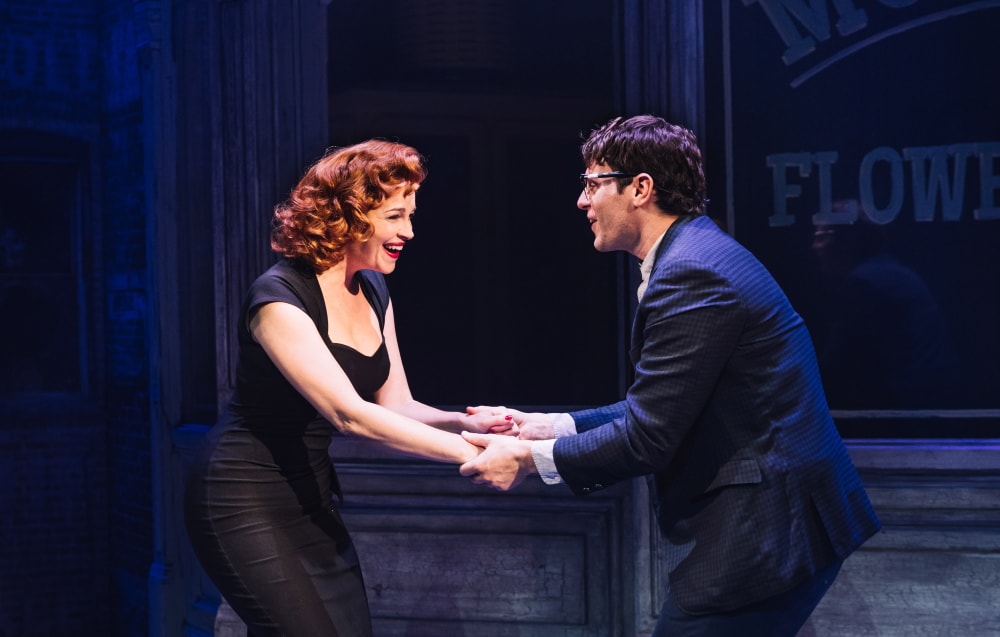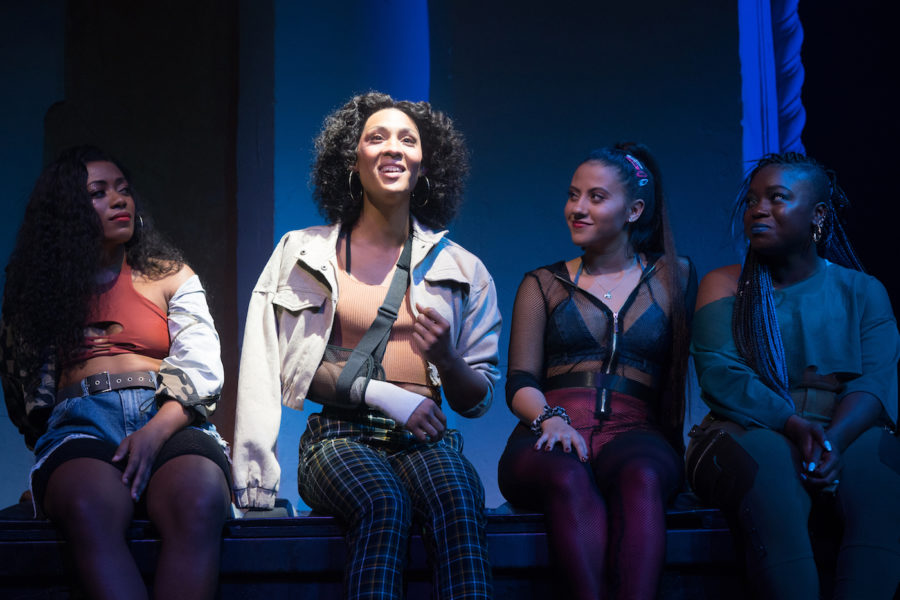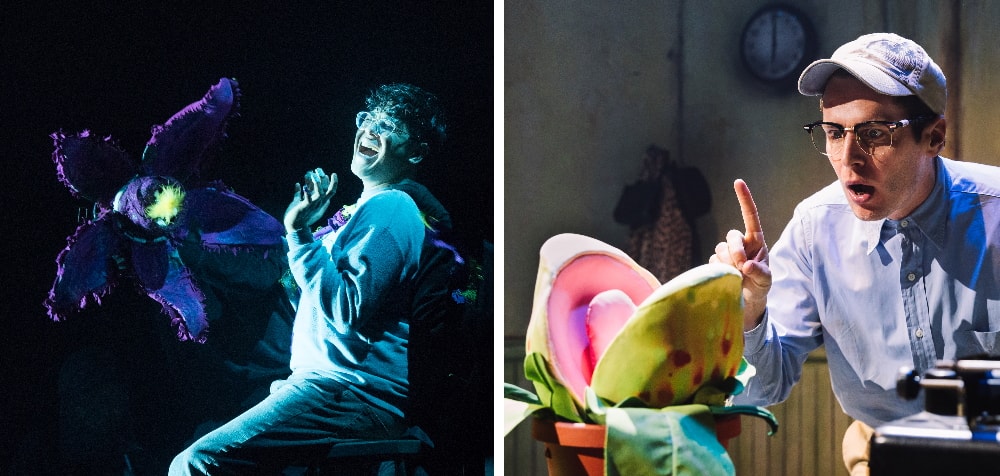“I’m gonna cry,” said Tiffany Haddish on opening night of Little Shop of Horrors at Pasadena Playhouse in California. It was the 25th day of the month of September, and the actors had just performed “Skid Row (Downtown),” an upbeat doo-wop anthem to the downtrodden and the desire for upward mobility. By a stroke of luck—or the generosity of the theatre gods—I was seated next to Haddish to witness her reactions to the production. (I can report that she was singing along throughout.)
Little Shop, that campy classic about a flower shop employee, Seymour, who finds a talking plant which brings him fame and fortune by eating his enemies, is known mostly for making audiences laugh, not cry. But the Pasadena Playhouse production, running through Oct. 20, is not a typical Little Shop.
The musical comedy with a dash of sci-fi horror first premiered Off-Broadway in 1982, created by Alan Menken and the late Howard Ashman, who would go on to create the iconic Disney musicals The Little Mermaid and Beauty and the Beast.
Right off the bat, Little Shop was an audience favorite, which was a bit surprising, as its subject matter is unusually dark: While Seymour uses the plant to win the heart of his lovably ditzy girlfriend, Audrey, the plant—which he christens Audrey II—becomes ravenous and demands human flesh, eventually eating both its master and its namesake. It’s simultaneously hilarious and tragic, with head-bopping songs and a message about how greed can corrupt personal morals.
Little Shop ran for five years Off-Broadway and remains one of the most produced musicals in American high schools. Its enduring popularity perhaps explains why, on Sept. 17, two high-profile, celebrity-laden revivals of the musical began running on opposite coasts. At Off-Broadway’s Westside Theatre, Jonathan Groff and Tammy Blanchard star as Seymour and Audrey, with Christian Borle as the sadistic dentist, Orin Scrivello. The West Coast version had Mj Rodriguez and George Salazar as Audrey and Seymour, and Amber Riley as Audrey II. (Not to mention that this season at least six other productions of Little Shop of Horrors are opening at professional theatres around the country.)
The bicoastal Little Shops constitute a coincidence almost as fortuitous as an asteroid carrying an invasive horticultural species hitting Earth. Seeing the East Coast and West Coast versions just weeks apart, I got a lesson in artistic interpretation, in the interplay between innovation and tradition, and in what a show is capable of saying if you have the courage to look into its green, taloned mouth and explore.

Little Shop is not yet old or classic enough, it seems, to have had many Daniel Fish Oklahoma!-style reimaginings. Its set and costumes are usually lifted straight out of its intended period, the 1960s. Indeed the look is so set in stone that Music Theatre International, which licenses the show, also provides rentals of Audrey II puppets modeled after Martin Robinson’s Off-Broadway design. Seymour and Audrey are almost always cast with white actors, and the street urchins/Motown chorus Crystal, Ronnette, and Chiffon are usually cast with Black actors. Audrey II is usually voiced by a man. Acting interpretations of the leads are pretty consistent too: Seymour is usually a clumsy bundle of nerves and “aw shucks,” with a bit of slapstick thrown in, and Audrey is an airhead in skin-tight animal prints with an over-the-top New Yawk accent.
So when Pasadena Playhouse announced it was casting actors of color as Seymour and Audrey (Rodriguez is Afro-Latina, Salazar is Asian-Latino), and Black actress Amber Riley as Audrey II, the news made national headlines. In an interview with Broadway.com, Rodriguez said, “My casting shouldn’t be something that’s trending—it should be normal.” She continues, “It’s simply because this role is always played by a Caucasian, cis-gendered blonde woman. And now it’s being played by a black, Latina, trans woman.”
While the West Coast Little Shop billed itself as modern and more “real,” the East Coast Little Shop’s aim was to bring 1982 to 2019. As director Michael Mayer told Vanity Fair, “I would say my goal with the production is to honor the brilliance of Howard Ashman as a director…His original conception for the show is I think part of the reason it has flourished so beautifully over these decades since it first emerged.”
So having seen both productions, I’m sure you as the reader want me to say: Which Little Shop is “better”? It depends on one’s definition of a successful revival. Whenever a classic is reimagined, there’s always a large contingent of people bemoaning the changes and appealing to tradition. It’s the “if it ain’t broke, don’t fix it” criticism.
And I’ll say, after watching the Off-Broadway Little Shop weeks after seeing the California Little Shop, I can see why many prefer the traditional treatment. The musical definitely has specific period references that sound out of place in a modern setting. The closing number, with Audrey II stretching out into the audience, filled me with equal parts glee and horror. Overall this production (currently booked through Jan. 19, 2020) demonstrates how much the show works as a piece of pure entertainment.
Indeed it moved like a machine, like it had done this a thousand times before. It’s the same feeling I get when I revisit long-running Broadway shows: You may exit having experienced a solid evening of theatre, but there’s something just emotionally off. The acting choices in this case seem to reduce the characters down to basic traits: Tammy Blanchard’s flighty Audrey seems to perpetually be on the verge of falling down while Jonathan Groff’s Seymour is serviceably besotted and slow. Lines are played for laugh rather than pathos. This is a Little Shop that knows its camp value and is playing that to the rafters. Not to mention that to my eyes, three Black women surrounding the white leads to offer advice has a mammy-ish vibe.
Those who loved the original Little Shop or its popular movie version will no doubt love the production, as it succeeds at what it sets out to do: Offer a nostalgic look at the thing that made many people fall in love with theatre in the first place. But as someone who doesn’t have any formative attachment to the musical, I wondered, as the audience cheered around me at curtain call, shouldn’t we feel a little more complicated and dirtied by a show in which the heroes get eaten by a giant plant?
Mere mimicry doesn’t seem to be what Ashman had in mind for subsequent productions of Little Shop. In the acting edition of the script, he wrote, “Little Shop of Horrors satirizes many things: science fiction, ‘B’ movies, musical comedy itself, and even the Faust legend. There will, therefore, be a temptation to play it for camp and low comedy. This is a great and potentially fatal mistake. The script keeps its tongue firmly in cheek, so the actors should not. Instead they should play with simplicity, honesty, and sweetness—even when events are at their most outlandish.”

Simplicity is the perfect word to describe the Pasadena Playhouse production, which director Mike Donahue has staged on a set so bare it looked like a butcher shop’s refrigerator. The characters are dressed in contemporary costumes: tight pants, crop tops, oversized T-shirts. The redesigned Audrey II (by Sean Cawelti) doesn’t grow the way it usually does. We only glimpse its full terrifying form (which looks like a glammed up demogorgon) for a minute as it is swallowing Audrey down its long neck. At the end, there is no overgrown Audrey II threatening to eat the audience (a missed opportunity). I didn’t feel scared by this production, but I did feel moved and disturbed.
Where this Little Shop stood out was that it treated its characters like real human beings. Seymour is a dim dweeb, but he is played with childlike vulnerability by Salazar. When he talked about how flower shop owner Mr. Mushnik “gave me a warm place to sleep under the counter. Nice things to eat like meatloaf and water. Floors to sweep and toilets to clean and every other Sunday off,” I laughed but felt guilty about it. I was laughing at abuse.
Mj Rodriguez’s Audrey becomes a wounded bird trapped in a toxic relationship not because she’s an airhead—she’s with the sadistic Orin because she’s been told by society that she is worthless her whole life, and she’s internalized that. Her story echoes the story of countless Black and trans women. So the audience doesn’t laugh away her black eye or broken arm; it makes us suck on our teeth. These characters are not cartoons but victims of abuse in a society that keeps them down and invisible. You can laugh, sure, but you’ll judge yourself for it. Casting faces of color in a classic show isn’t a case of being trendy; it opens up the musical for wider interpretations.
The ending of this version of Little Shop made me think of the ending of another piece of narrative art currently gaining buzz, Bong Joon-ho’s film Parasite. In it, a poor Korean family depends on a rich Korean family for jobs and stability, with chaotic results. It is equal parts funny and unsettling, and when the dark ending came, it left me feeling knotted, much as I felt after seeing the Pasadena Little Shop. I could not judge this Seymour for giving Audrey II his blood. As in Parasite, in a time when upward mobility seems to be an ever-shrinking possibility, and the income gap between the rich and poor is widening, what can the desperate do but bleed themselves dry? In America, some poor people have resorted to selling their blood for just a little money.
Granted, I doubt that Alan Menken and Howard Ashman intended their little spoof of low-budget horror movies to be a critique of late-stage capitalism.* But its body is big enough to digest that take. After all, in Reagan-era America, before the rise of modern Wall Street, the musical could be seen as a cautionary tale. But 36 years later, as we see the fallout of unchecked financialization and the rising income gap, somewhere that’s green seems even further from reach. Now more than ever, the only way to get ahead seems to be to step on another person. The musical is no longer cautionary; it’s reality. As in Parasite, Pasadena’s Little Shop shows us marginalized people trying to claw their way up in a system designed to extract every hint of humanity and moral decency from them, only to come out the other side damaged and traumatized. This version’s Audrey II takes over the world not by force, but due to the willingness of everyday people to sacrifice their fellow citizens to its gaping maw. Left unchecked, capitalism will likewise eat us all.
Whether traditional or innovative, it seems audiences are game for both versions of Little Shop. Both easily sold out. A source close to the Pasadena production told me there’s interest in taking the show to London and Warner Music Group has offered to fund a cast album. Unfortunately, New York holds exclusive rights to any future transfers or recordings. It’s a shame because seeing both in tandem, or even listening to them, is an experience I wish many more people can have.
If the mark of a classic piece of theatre is its ability to withstand reinterpretation, Little Shop of Horrors seems to be a classic. It can hold many worlds within it, just as Audrey II can hold many bodies.
*After this piece was published, composer Alan Menken said on Twitter that the late-stage capitalism critique is intended. Something to think about for future productions.
Thanks for sharing, Sarah. Actually, it was intended.
— Alan Menken (@AIMenken) October 22, 2019


